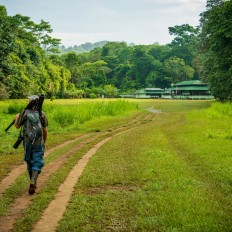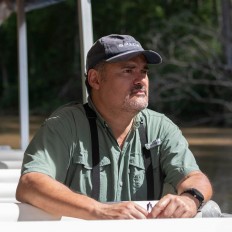Top species
- Scaled Pigeon (Patagioenas speciosa)
- Chiriqui Quail-Dove (Zentrygon chiriquensis)
- Green Hermit (Phaethornis guy)
- White-crested Coquette (Lophornis adorabilis)
- Garden Emerald (Chlorostilbon assimilis)
- White-tailed Emerald (Microchera chionura)
- Snowy-bellied Hummingbird (Saucerottia edward)
- Sunbittern (Eurypyga helias)
- Brown-hooded Parrot (Pyrilia haematotis)
- Blue-headed Parrot (Pionus menstruus)
- Crimson-fronted Parakeet (Psittacara finschi)
- Plain Antvireo (Dysithamnus mentalis)
- Middle American Leaftosser (Sclerurus mexicanus)
- Olivaceous Woodcreeper (Sittasomus griseicapillus)
- Ruddy Woodcreeper (Dendrocincla homochroa)
- Brown-billed Scythebill (Campylorhamphus pusillus)
- Ruddy Foliage-gleaner (Clibanornis rubiginosus)
- White-ruffed Manakin (Corapipo altera)
- Scale-crested Pygmy-Tyrant (Lophotriccus pileatus)
- Scaly-breasted Wren (Microcerculus marginatus)
- Rufous-breasted Wren (Pheugopedius rutilus)
- Elegant Euphonia (Chlorophonia elegantissima)
- Costa Rican Brushfinch (Arremon costaricensis)
- Crested Oropendola (Psarocolius decumanus)
- Tropical Parula (Setophaga pitiayumi)
- Golden-crowned Warbler (Basileuterus culicivorus)
- Slate-throated Redstart (Myioborus miniatus)
- Speckled Tanager (Ixothraupis guttata)
- Bay-headed Tanager (Tangara gyrola)
- Silver-throated Tanager (Tangara icterocephala)
- Scarlet-thighed Dacnis (Dacnis venusta)
- Green Honeycreeper (Chlorophanes spiza)
- Yellow-faced Grassquit (Tiaris olivaceus)
List up to ca. 25 species that:
• have a limited distribution range and/or are rare on a global level
• are most sought-after by birdwatchers at this site
• and are relatively easy to see at this site (year-round or seasonally)
| Scaled Pigeon (Patagioenas speciosa) | |
| Chiriqui Quail-Dove (Zentrygon chiriquensis) | |
| Green Hermit (Phaethornis guy) | |
| White-crested Coquette (Lophornis adorabilis) | |
| Garden Emerald (Chlorostilbon assimilis) | |
| White-tailed Emerald (Microchera chionura) | |
| Snowy-bellied Hummingbird (Saucerottia edward) | |
| Sunbittern (Eurypyga helias) | |
| Brown-hooded Parrot (Pyrilia haematotis) | |
| Blue-headed Parrot (Pionus menstruus) | |
| Crimson-fronted Parakeet (Psittacara finschi) | |
| Plain Antvireo (Dysithamnus mentalis) | |
| Middle American Leaftosser (Sclerurus mexicanus) | |
| Olivaceous Woodcreeper (Sittasomus griseicapillus) | |
| Ruddy Woodcreeper (Dendrocincla homochroa) | |
| Brown-billed Scythebill (Campylorhamphus pusillus) | |
| Ruddy Foliage-gleaner (Clibanornis rubiginosus) | |
| White-ruffed Manakin (Corapipo altera) | |
| Scale-crested Pygmy-Tyrant (Lophotriccus pileatus) | |
| Scaly-breasted Wren (Microcerculus marginatus) | |
| Rufous-breasted Wren (Pheugopedius rutilus) | |
| Elegant Euphonia (Chlorophonia elegantissima) | |
| Costa Rican Brushfinch (Arremon costaricensis) | |
| Crested Oropendola (Psarocolius decumanus) | |
| Tropical Parula (Setophaga pitiayumi) | |
| Golden-crowned Warbler (Basileuterus culicivorus) | |
| Slate-throated Redstart (Myioborus miniatus) | |
| Speckled Tanager (Ixothraupis guttata) | |
| Bay-headed Tanager (Tangara gyrola) | |
| Silver-throated Tanager (Tangara icterocephala) | |
| Scarlet-thighed Dacnis (Dacnis venusta) | |
| Green Honeycreeper (Chlorophanes spiza) | |
| Yellow-faced Grassquit (Tiaris olivaceus) |
Scarlet-thighed Dacnis (Dacnis venusta) was added by Dionisio Paniagua Castro (2023-05-10 22:36:21)
Green Honeycreeper (Chlorophanes spiza) was added by Dionisio Paniagua Castro (2023-05-10 22:35:48)
Scale-crested Pygmy-Tyrant (Lophotriccus pileatus) was added by Dionisio Paniagua Castro (2023-05-10 22:35:28)
Scaly-breasted Wren (Microcerculus marginatus) was added by Dionisio Paniagua Castro (2023-05-10 22:33:36)
Rufous-breasted Wren (Pheugopedius rutilus) was added by Dionisio Paniagua Castro (2023-05-10 22:33:10)
Yellow-faced Grassquit (Tiaris olivaceus) was added by Dionisio Paniagua Castro (2023-05-10 22:32:47)
Tropical Parula (Setophaga pitiayumi) was added by Dionisio Paniagua Castro (2023-05-10 22:32:15)
Olivaceous Woodcreeper (Sittasomus griseicapillus) was added by Dionisio Paniagua Castro (2023-05-10 22:31:54)
Brown-billed Scythebill (Campylorhamphus pusillus) was added by Dionisio Paniagua Castro (2023-05-10 22:31:34)
Golden-crowned Warbler (Basileuterus culicivorus) was added by Dionisio Paniagua Castro (2023-05-10 22:31:03)
Slate-throated Redstart (Myioborus miniatus) was added by Dionisio Paniagua Castro (2023-05-10 22:30:43)
Sunbittern (Eurypyga helias) was added by Dionisio Paniagua Castro (2023-05-10 22:30:09)
Chiriqui Quail-Dove (Zentrygon chiriquensis) was added by Dionisio Paniagua Castro (2023-05-10 22:29:53)
Scaled Pigeon (Patagioenas speciosa) was added by Dionisio Paniagua Castro (2023-05-10 22:29:37)
Silver-throated Tanager (Tangara icterocephala) was added by Dionisio Paniagua Castro (2023-05-10 22:28:52)
Bay-headed Tanager (Tangara gyrola) was added by Dionisio Paniagua Castro (2023-05-10 22:28:34)
Middle American Leaftosser (Sclerurus mexicanus) was added by Dionisio Paniagua Castro (2023-05-10 22:28:11)
Ruddy Woodcreeper (Dendrocincla homochroa) was added by Dionisio Paniagua Castro (2023-05-10 22:27:28)
Ruddy Foliage-gleaner (Clibanornis rubiginosus) was added by Dionisio Paniagua Castro (2023-05-10 22:27:11)
White-ruffed Manakin (Corapipo altera) was added by Dionisio Paniagua Castro (2023-05-10 22:26:43)
Plain Antvireo (Dysithamnus mentalis) was added by Dionisio Paniagua Castro (2023-05-10 22:26:27)
Elegant Euphonia (Chlorophonia elegantissima) was added by Dionisio Paniagua Castro (2023-05-10 22:26:05)
Speckled Tanager (Ixothraupis guttata) was added by Dionisio Paniagua Castro (2023-05-10 22:25:43)
Crested Oropendola (Psarocolius decumanus) was added by Dionisio Paniagua Castro (2023-05-10 22:24:31)
Snowy-bellied Hummingbird (Saucerottia edward) was added by Dionisio Paniagua Castro (2023-05-10 22:23:22)
Green Hermit (Phaethornis guy) was added by Dionisio Paniagua Castro (2023-05-10 22:23:05)
Blue-headed Parrot (Pionus menstruus) was added by Dionisio Paniagua Castro (2023-05-10 22:22:50)
Brown-hooded Parrot (Pyrilia haematotis) was added by Dionisio Paniagua Castro (2023-05-10 22:22:25)
Crimson-fronted Parakeet (Psittacara finschi) was added by Dionisio Paniagua Castro (2023-05-10 22:22:06)
White-crested Coquette (Lophornis adorabilis) was added by Dionisio Paniagua Castro (2023-05-10 22:21:30)
Costa Rican Brushfinch (Arremon costaricensis) was added by Dionisio Paniagua Castro (2023-05-10 22:21:09)
Garden Emerald (Chlorostilbon assimilis) was added by Dionisio Paniagua Castro (2023-05-10 22:20:36)
White-tailed Emerald (Microchera chionura) was added by Dionisio Paniagua Castro (2023-05-10 22:20:18)



